Final Days of the Stock Market Bubble
Stock-Markets / Stock Markets 2014 Jul 15, 2014 - 03:39 PM GMTBy: LewRockwell
 David A. Stockman writes: The central banks of the world are massively and insouciantly pursuing financial instability. That’s the inherent result of the 68 straight months of zero money market rates that have been forced into the global financial system by the Fed and its confederates at the BOJ, ECB and BOE. ZIRP fuels endless carry trades and the harvesting of every manner of profit spread between negligible “funding” costs and positive yields and returns on a wide spectrum of risk assets.
David A. Stockman writes: The central banks of the world are massively and insouciantly pursuing financial instability. That’s the inherent result of the 68 straight months of zero money market rates that have been forced into the global financial system by the Fed and its confederates at the BOJ, ECB and BOE. ZIRP fuels endless carry trades and the harvesting of every manner of profit spread between negligible “funding” costs and positive yields and returns on a wide spectrum of risk assets.
Moreover, this central bank sponsored regime of ZIRP and money market pegging contains a built-in accelerator. As carry trade speculators drive asset prices steadily higher and fixed income spreads steadily thinner—- fear and short interest is driven out of the casino, making buying on the dips ever more profitable and less risky. Indeed, the explicit promise by central banks that the money market rate will remain frozen for the duration and that ample warning of any change in rate policy will be “transparently” announced is the single worst policy imaginable from the point of view of financial stability. It means that the speculator’s worst nightmare—–suddenly going “upside down” due to a sharp spike in funding costs—-is eliminated by central bank writ.
Stated differently, ZIRP systematically dismantles the market’s natural stability mechanisms.One natural deterrent to excessive financial gambling, for example, is the cost of hedging a speculator’s portfolio of “risk assets” against a broad market plunge. In an honest market environment, hedging costs consume a high share of profits, thereby sharply limiting risk appetites and the amount of capital attracted to speculative trading.
By contrast, an extended regime of ZIRP, coupled with the central banks’ perceived “put” under risk assets, drives the cost of “downside insurance” to negligible levels because S&P 500 put writers are emboldened and subsidized to pick up nickels (i.e. options premium) in front of a benign central bank steamroller. This ultra-cheap downside insurance, in turn, attracts ever larger inflows of speculative capital to the casino.
This corrosive game has been underway ever since the Greenspan Fed panicked on Black Monday in October 1987 and flooded the stock market with liquidity. It is now such an endemic feature of Wall Street that it is falsely assumed to be the normal order of things. But, then, would anyone have been picking up nickels in front of the Volcker steamroller?
This dynamic is evident in the chart of the S&P 500 since the March 2009 bottom. The dips have gotten shallower and shallower as ZIRP and other pro-risk central bank policies have eroded the market’s natural defenses against excessive speculation. As of mid-2014, therefore, it can be fairly said that fear and short interest have been extinguished almost entirely. The Wall Street casino has thus become a one-way market that coils dangerously upward, divorced completely from the fundamentals of earnings and cash flow and real world economic conditions and prospects.
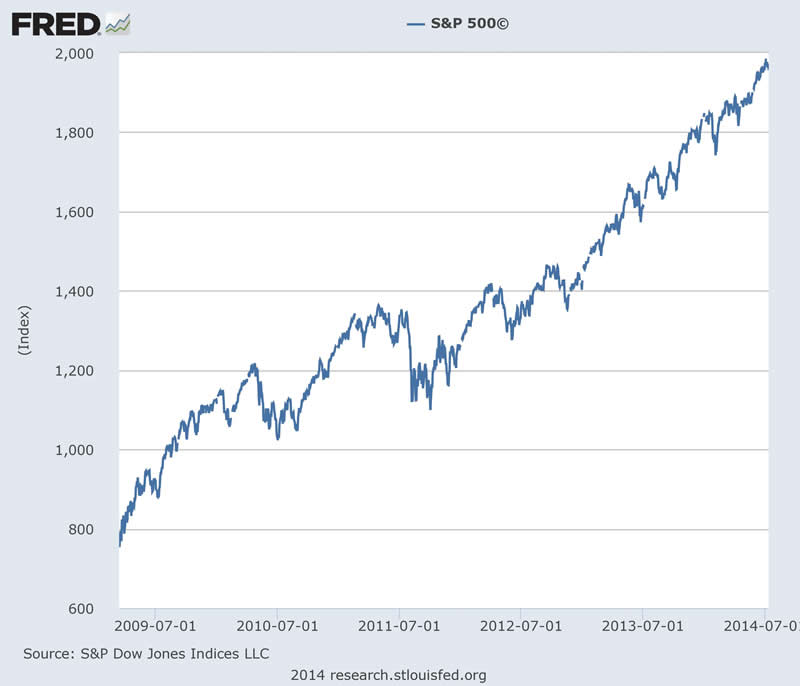
The inverse side of this coin is disappearance of volatility in the equity markets. As shown below, the current readings are at all-time lows, even below bottoms reached on the eve of the 2008 financial crisis. Needless to say, this dangerous condition does not appear by happenstance: its is the inexorable and systematic result of ZIRP and the associated tools of monetary central planning.
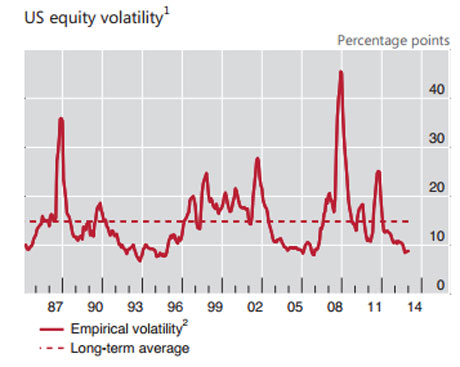
But all of this is ignored by the central banks because their Keynesian economic plumbing models contain a fatal flaw. These models purport to capture capitalism at work, but they contain no balance sheets and hardly any proxy for the financial markets which are at the heart of modern capitalist economies. As a result, central banks pursue ZIRP in order to inflate the plumbing system of the macro-economy with more “demand”—and hence more jobs, income, investment and GDP—-while ignoring the systematic destruction of financial stability that results from these very same policies.
As a consequence, Keynesian central bankers are bubble-blind. Whereas they monitor immense amounts of “in-coming” high-frequency macro-economic data that is trivial and “noisy” in the extreme, they ignore entirely “in-coming” financial market data that points to monumental troubles just ahead.
At the present time, for example, 40% of all syndicated loans are being taken down by sub-investment grade issuers. This is materially higher than the 2007 peak, and is accompanied by an even more virulent outbreak of “cov-lite” credit terms. Indeed, upwards of 60% of these junk loans have no protection against debt layering and cash stripping by equity holders—-notwithstanding their nominal “senior” status in the credit structure. The obvious implication, of course, is that the Fed “easy money” is being massively diverted into leveraged gambling and rent stripping by the LBO houses. Three times since 1988 this kind of financial deformation has led to a thundering bust in the junk credit market. Why would monetary central planners, who allegedly watch their so-called “dashboards” like a flock of hawks, think the outcome would be any different this time?
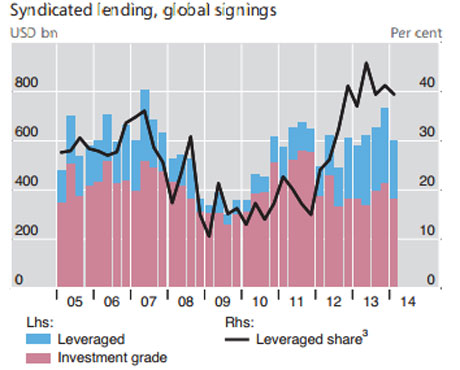
40pc of syndicated loans are to sub-investment grade borrowers
The monetary politburo remains unperturbed, of course, because they are not monitoring the composition and quality of credit. Their models simply stipulate that aggregate business loan growth will lead to more spending on capital assets and operational expansion including hiring. That assumption is manifestly wrong, however, because it is plainly evident that most of the massive expansion of business credit since the last peak has gone into financial engineering—-stock buybacks, LBO’s and cash M&A deals—-not expansion of productive business assets. Indeed, total non-financial business credit outstanding has risen from $11 trillion in December 2007 to $13.8 trillion at present, or by 25%, yet real business investment in plants and equipment is still $70 billion or 5% below its pre-crisis peak.
And that is “gross” spending for plant and equipment as recorded in the “I” term of the GDP accounts. The far more relevant measure with respect to economic health and future growth capacity is “net business investment” after accounting for depreciation and amortization allowances. That is, after accounting for the consumption of capital that occurred in the production of current period GDP. As shown below, that figure in real terms is 20% below the peak achieved two cycles back in the late 1990s.
In short, the combination of faltering investment in real plant and equipment juxtaposed to peak levels of leveraged loan finance should be a warning sign of growing financial instability. Instead, the central bankers bray that valuation multiples are not out of line and financial institution leverage is reasonably well-contained.
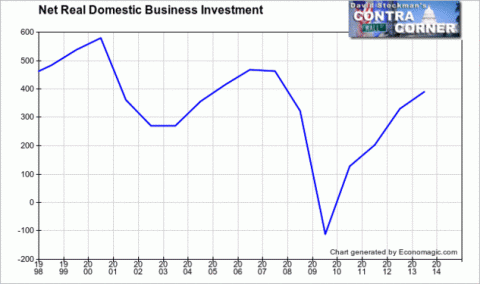
The “valuations are normal” line proffered by Yellen and her band of money printers, however, is simply an adaptation of the Wall Street hockey sticks based on projected earnings ex-items. That is to say, the kind of “earnings” estimates that omitted on average 23% of actual P&L charges over the course the 2007-2010 boom and bust cycle owing to non-recurring write-downs of goodwill, plants, leases and restructuring costs, among countless other real expenses—all of which ultimately consume corporate cash and capital. As I demonstrated in “The Great Deformation”, cumulative S&P 500 “earnings less items” over that four-year period amounted to $2.42 trillion compared to GAAP reported earnings—-that is, the kind that you don’t go to jail for reporting to the SEC—of only $1.87 trillion.
Consequently, the Fed fails to see the in-coming data on financial instability because it isn’t looking for it, and is simply tossing out Wall Street sell-side propaganda as a sop. The disappearance of volatility in the S&P 500 chart shown at the beginning, for example, is nearly an identical replica of the run-up to the 2007 stock market peak. Yet the appearance of a proven warning sign of a bubble top has been resolutely ignored.
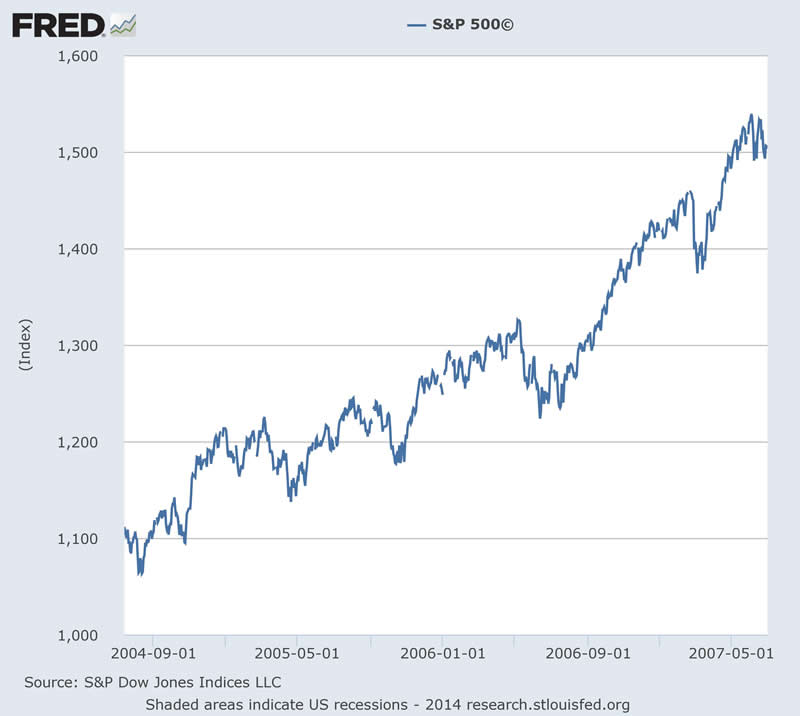
The fact is, PE multiples are far above “normal” based on GAAP earnings in historical context. During the LTM period ending in Q1 2014, S&P 500 earnings amounted to $100 per share after adjustment for a recent change in pension accounting that is not reflected in the historical data. Accordingly, even the big cap “broad” market is trading at 19.6X reported earnings—a level achieved historically only at points when the stock market was on the verge of implosion.
Moreover, today’s $100 per share of earnings are highly artificial owing to massive share buybacks funded by cheap debt and by deep repression of interest carry costs. The S&P 500 companies carry upwards of $3 trillion in debt, but were interest rates to normalize— earnings per share would drop by upwards of $10. Likewise, profit margins are at an all-time high, indicating that the inevitable “mean-regression” will chop significant additional amounts out of currently reported profits.

In other words, at a point which is month #61 of the current business cycle, and thereby already beyond than the average cycle since 1950, why would any one in their right mind say a market is not bubbly when it’s trading at nearly 20X reported earnings. Indeed, in a world where interest rate and profit rate normalization must inevitably come, the capitalization rate for current earnings should be well below normal—-not extended into the nosebleed section of historical results.
And this applies to almost any other measure of valuation in risk asset markets. The Russell 2000, for example, still stands at the absurd height of 85X reported earnings. The cyclically adjusted S&P stands at 24X, or six turns higher than its half century average. The Tobin’s Q measure is also far more stretched than in 2007.
Likewise, emerging markets have piled on $2 trillion in foreign currency debt since 2008. This makes them far more significant in the global financial scheme than they were in 2008 or even at the time of the East Asia crisis of the late 1990s. And that is not even considering the massive house of cards in China, where credit market debt has soared from $1 trillion at the turn of the century to $25 trillion today.
At the end of the day, the Fed and its fellow traveling central banks have systematically dismantled the natural stability mechanisms of financial markets. Accordingly, financial markets have now become dangerous casinos in which speculative bubbles are guaranteed to build to dangerous extremes as the central bank driven financial inflation gathers force. That’s where we are now. Again.
Former Congressman David A. Stockman was Reagan's OMB director, which he wrote about in his best-selling book, The Triumph of Politics. His latest book is The Great Deformation: The Corruption of Capitalism in America. He was an original partner in the Blackstone Group, and reads LRC the first thing every morning.© 2013 Copyright David A. Stockma, LewRockwell.com - All Rights Reserved
Disclaimer: The above is a matter of opinion provided for general information purposes only and is not intended as investment advice. Information and analysis above are derived from sources and utilising methods believed to be reliable, but we cannot accept responsibility for any losses you may incur as a result of this analysis. Individuals should consult with their personal financial advisors.
© 2005-2022 http://www.MarketOracle.co.uk - The Market Oracle is a FREE Daily Financial Markets Analysis & Forecasting online publication.



